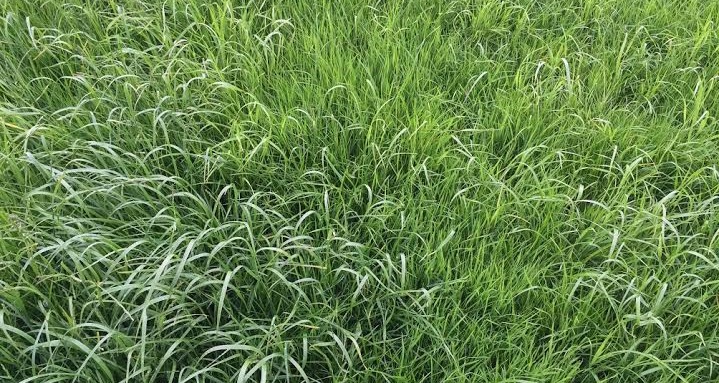
Farmers participating in Grass into Gold, a UK-wide research initiative exploring the impact that proactive grassland management can have on yields, are starting to see results after implementing suggestions put forward by Barenbrug, the company behind the scheme.
Ten farms across England, Northern Ireland, Scotland and Wales are involved in Grass into Gold, which Barenbrug launched in late spring. The aim of the scheme, which is supported by Dow Agrosciences, is to help UK farmers hone their grassland management skills in order to improve the quantity and quality of dry matter per hectare as well as overall profitability.
Over the summer Barenbrug’s forage grass experts have been conducting field assessments at all ten Grass into Gold farm and drawing up action plans to help address persistent pasture problems. While each farm faces its own challenges and is at a different stage in its Grass into Gold work, the farmers that have started to renew pastures are beginning to notice improvements that they hope will help them combat continuing farm gate price pressures.
In Northern Ireland, Barenbrug’s David Linton is working with Ian and Ruth Pollock from Braemar Farm in County Londonderry. The Pollocks’ 200-acre dairy farm has a 120-strong herd of Holsteins, producing around 8,000 litres of milk a year – a proportion of which goes to a local creamery. The rest heads straight to the family’s artisan ice cream business. Traditionally, the Pollocks have re-seeded every eight years but the last reseeding – three years ago – gave disappointing results. Existing swards have proved slow in spring and produced more silage in the second cut. To balance out growth, Barenbrug recommended that the Pollocks burn off the existing sward and stitch in a new seed mixture. Combining intermediate and late heading ryegrasses, the mixture sown gives top quality grass when it is most needed, with maximum production throughout the year, but extra emphasis on the first cut. For the Pollocks, the ambition is to achieve an increase in first cut silage yields and improve grass D-value and sward density – and so far, growth looks promising.
Derbyshire dairy farmers Melvyn and Diane Shepherd from Hassop have been working with Barenbrug’s Roger Bacon to renovate a field utilised for both silage and grazing. The field had a chickweed and seedling dock problem so a combination mixture, without clover, was sown. Just seven days after sowing the new grass emerged, producing a nice even plant stand. The team are now looking at renovating a separate silage field.
In Wales, James Ingles, Head of Agriculture at Barenbrug, is working with Richard Morris from Southern Pitts Farm, Pembrokeshire. Southern Pitts is a 370-acre spring calving dairy farm based on a year-round grazing platform. The business is a relatively new venture for Richard, who owns another farm further south. With an intensive grazing system in place, Richard pays close attention to his grass, measuring growth weekly. As part of Grass into Gold the plan is to sharpen his sward skills further. To improve the economics of his milk production, a number of pastures, including fields that can’t be deep cultivated, have been reseeded with a mixture of DUNLUCE, TYRELLA and DRUMBO. Results will be monitored carefully over the coming months.
In Scotland, Mhairi Dawson is helping Grass into Gold farmers tackle typical Scottish grassland challenges such as high rainfall and heavy soils, which can seriously hinder silage results. At Longlea Farm in South Lanarkshire, Mhairi is giving Robert and Charlotte Baillie a hand to improve results at the three cut stages of the farm’s silage regime. Areas for soil sampling and overseeding are currently being selected. Further north in Stirlingshire, Barenbrug is working with Mark Donald and Harriet Smith – who are in the early stages of setting up their sheep farming business. Harriet and Robert were awarded a ten-year lease at Rynaclach Farm as part of the Forestry Commission Scotland’s Starter Farm scheme. The couple have big plans for the farm, which has thirteen fields – all in need of work. With a variety of issues to deal with, including rushes, docks, compaction and pH problems, Mhairi has suggested mapping out the weeds to track their growth year on year, then spraying to remove them. In parallel, a programme of overseeding is being devised for the spring to make the most of each field’s individual characteristics.
James Ingles said: “It’s been a busy start to Grass into Gold for our 2015 intake of farmers. As well as their usual summer tasks, participants have made time for lengthy meetings with our forage team. Each farm clearly faces different challenges but they all have one thing in common; they recognise the benefits of investing in grass as a crop and understand that getting it right can have a really positive impact on farm finances. At a time of continuing pressure on farm gate prices, farmers needs to capitalise on every opportunity to improve profitability. Through Grass into Gold our aim is to show how simple, cost effective grassland management techniques can be used to great effect. It’s early days for our farmers – and there is still lots to do – but initial indications look like they’ll be seeing good results next year.”
Work is ongoing with Barenbrug’s Grass into Gold farmers across the UK. The others farms taking part in the programme – and not mentioned above – include:
• Craig Malone – Pitcairn Farm, Cardenden, Fife (Beef & Sheep)
• Mike Miller – Greville Hall Farm, Evesham, Worcestershire (Dairy)
• Elizabeth Benton – Cucumber Farm, Chichester, West Sussex (Dairy)
• R G Bacon – Hadcliffe Farm, Wadshelf, Derbyshire (Mixed)
•Sean Fullerton – Maghera, County Londonderry (Dairy)
